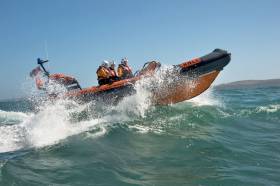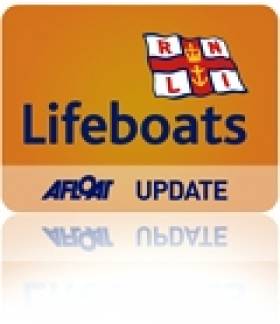Displaying items by tag: Baltimore
#RNLI - Baltimore RNLI’s inshore lifeboat was launched on Saturday night (29 May) to assist a boat that had broken from its moorings in Baltimore Harbour.
Concerned for the safety of a person seen trying to access the boat from a rowing dinghy in strong southerly winds, a member of the public raised the alarm, and the ILB was tasked to assist, quickly returning the boat it its morning and its occupant back to shore.
On return to station, the lifeboat was tasked to investigate a possible flare sighting in the area.
After conducting a search in strong wind, rain and darkness, nothing was out of the ordinary was found and the ILB was stood down.
The Baltimore lifeboat crew on this callout were Mícheál Cottrell, Ryan O’Mahony and Colin Rochford, with Seamus O’Driscoll, Rianne Smith and Jerry Smith on shore and Brian McSweeney also in attendance.
Baltimore Sea Safari in West Cork have posted this photo of a Humpback Whale breaching off the West Cork coast.
Baltimore Drowning Deaths 'Accidental', Inquest Hears
#Baltimore - A verdict of accidental death was returned at Clonakilty courthouse today (Tuesday 26 April) in the deaths of a Penney's retail scion, his son and his son's girlfriend, all three of whom drowned off Baltimore in West Cork last summer.
According to RTÉ News, the inquest heard coroner Frank O'Connell describe Barry St John Ryan (51) as an "extremely brave and courageous man" for entering the water to attempt to rescue his son Barry Davis Ryan (20) and Niamh O'Connor (20) after they were swept into the sea from the rocks by an unexpected wave on 30 June last.
The bodies of Ryan Sr and O'Connor were recovered soon after, while Ryan Jr was found by divers 10 days later, as previously reported on Afloat.ie.
The court heard an emotional statement from Ryan Sr's daughter Charlotte, who was 12 years old at the time, and who recalled how an afternoon out fishing from the shore at a popular beauty spot suddenly turned to tragedy.
RTÉ News has more on the story HERE.
Baltimore Drone Footage Shows Off IODAI Optimist Training Camp
It may have had a breezy conclusion but last Monday and Tuesday were amazing days in Baltimore for the IODAI Optimist training week with sunshine, light winds and as this drone footage shows beautiful West Cork boating scenery.
Baltimore Lifeboat Tasked With Medevac From Cape Clear Island
Baltimore RNLI received an an alert from Valentia Coastguard at 09:29 this morning when a young boy in urgent need of medical attention required immediate evacuation from Cape Clear Island.
Coxswain Aidan Bushe along with 5 volunteer crewmen were launched within minutes of the alert. They proceeded in poor weather conditions to the North Harbour of Cape Clear Island against a swell of 3 metres and force 6-7 northwest winds.
When the lifeboat crew arrived at the pier the little boy was unresponsive. He was immediately stretchered aboard the the lifeboat where he was constantly monitored on the journey back to Baltimore. The lifeboat arrived at Baltimore pier at 10:30, from where the boy was transferred to Skibbereen for medical attention.
The evacuation was successfully completed in one hour, a remarkable achievement given that current weather conditions have meant frequent cancellation of local ferries.
On board were ; Coxswain Aidan Bushe, Mechanic Cathal Cottrell, crew Sean McCarthy, Jerry Smith, Ronnie Carty and Don O'Donovan
Baltimore Lifeboat Assists Fishing Vessel Aground at Glandore Harbour
Baltimore RNLI Tamar class Lifeboat Alan Massey launched last night to go to the assistance of a fishing vessel which ran aground in Glandore Harbour. The Lifeboat was tasked at 2125 and arrived in Glandore Harbour where the Union Hall Inshore Lifeboat was evacuating the crew from the stricken vessel. The fishing vessel subsequently drifted off the rocks and was taken in tow by the Baltimore Lifeboat towards the safety of Union Hall.
Weather conditions are force 7 to 8 with a 4 metre swell offshore but the vessel grounded in the more sheltered waters of Glandore Harbour. On board the Baltimore Lifeboat were; Coxswain Kieran Cotter Mechanic Jerry Smith. Crew Pat Collins, Kieran Collins, Don O’Donovan, Ronnie Carty and Colin Whooley
Humpback Wows Whale Watchers With Breach Off Baltimore
#MarineWildlife - Whale Watch West Cork have shared this incredible video of one of a humpback whale breaching off Baltimore this week.
The whale is one of three of the ocean giants seen feeding off Baltimore and nearby islands in recent days, and caught in some stunning shots by photographer Simon Duggan, among others.
Meanwhile, some no less impressive sights have been seen of Donegal, new video shows basking sharks - the second biggest fish in the sea - breaching off Malin Head.
Bren Whelan of Wild Atlantic Way Climbing told Independent Travel that it's been an "outstanding week" for marine wildlife watching on the North Coast, saying he himself had witnessed "over 300" basking shark breaches.
Basking sharks have been seen in big numbers the area all month long, with 15 spotted during the Irish Whale and Dolphin Group's Whale Watch Ireland 2015 event on the afternoon of 23 August alone.
Baltimore Lifeboat Rescues Man From Boat On Tragumna Rocks
Baltimore All Weather Lifeboat (ALB) 'Alan Massey' was launched today to act as back-up for Baltimore inshore lifeboat, which was tasked to go the aid of a boat that went onto rocks on the island at Tragumna.
The male occupant of the 18ft punt managed to scramble ashore onto the island. When the ilb crewed of Youen Jacob, Kieran Collins and Jason Pavrey arrived on scene they dropped an anchor, so that they could safely veer the lifeboat through a heavy swell and a wave washed shoreline to rescue the boats occupant.
The casualty was then passed over to Baltimore alb for his comfort and safety on the journey back to his departure point. The lifeboats were aided by Toe Head CG who assisted in recovery of the boat, which was then towed by Baltimore ilb to its mooring in Trá na mBhó.
The alb was crewed by Aidan Bushe coxswain, Cathal Cottrell mechanic, Sean McCarthy, Don O' Donovan and Ronnie Carthy.
Baltimore Aerial Photo Shows off West Cork Harbour At Its Best
Baltimore Lifeboat In Medevac From Cape Clear Island
#RNLI - Baltimore RNLI's lifeboat was launched at 11.38pm last night (Saturday 11 July) to convey a sick teenager from Cape Clear Island to Baltimore.
The teen, who was suffering from an appendicitis, was transferred from the island aboard the lifeboat Alan Massey to Baltimore Lifeboat Station, from where an ambulance brought her to hospital in Cork.
Equipment was then cleaned and stored, and the lifeboat was ready for service again by 1.10am.
The crew were Kieran Cotter, Pat Collins, Jerry Smith, Don O'Donovan, Colin Whooley, Sean McCarthy and Mícheál Cottrell. Shore helpers at the station were Brian McSweeney, Aidan Bushe and Youen Jacob.


































































